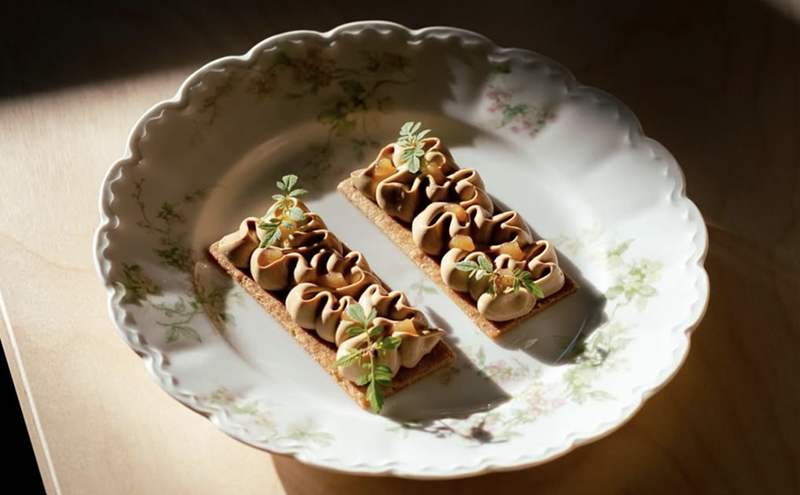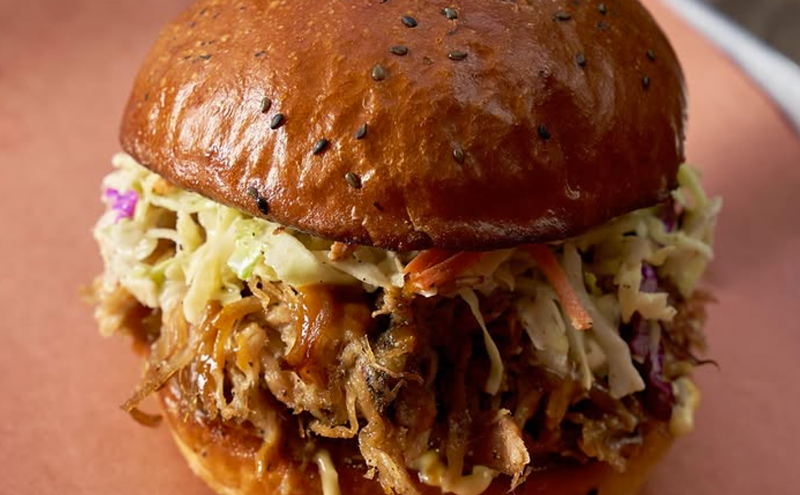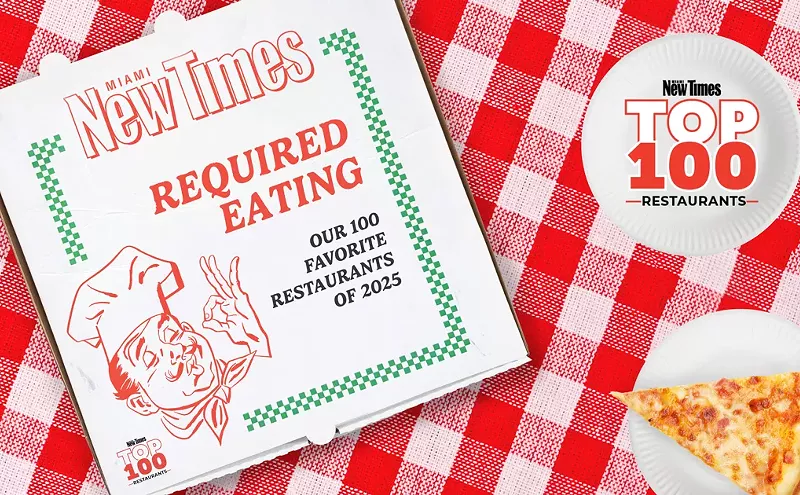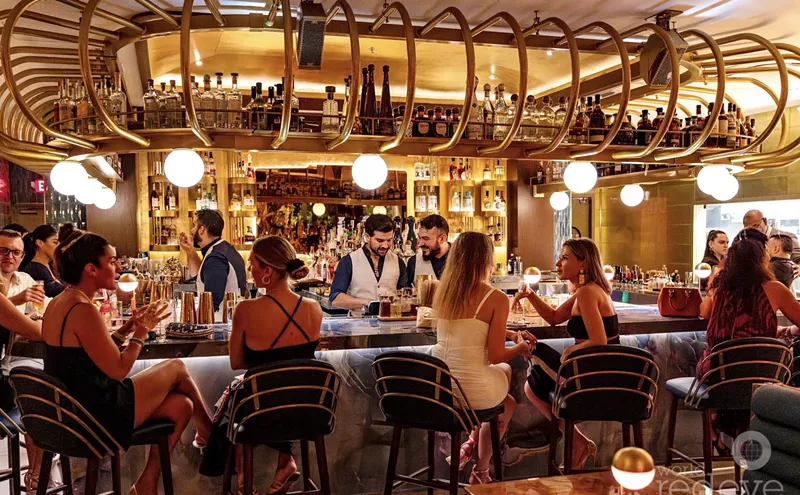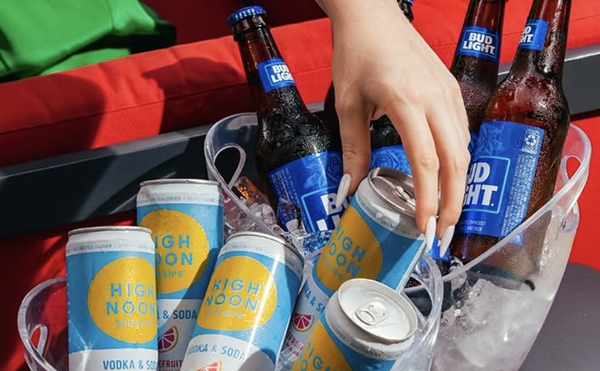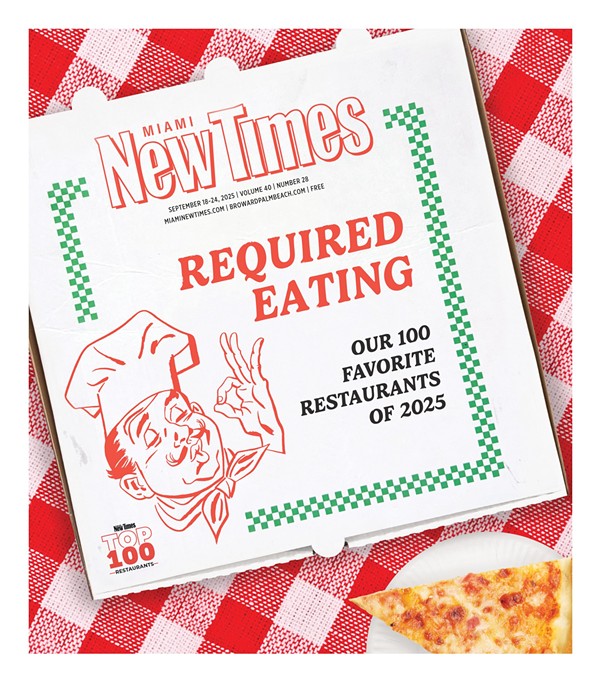When diners enter Toscana Divino, they're greeted with a rehearsed welcome from behind a sleek hostess stand, as the staff bellows, "Buona sera!" Lustrous wooden tables are adorned with fuchsia flowers and colorful handmade Tuscan glassware. Dark-gray shelves, highlighted by subdued LED strips, showcase stylish designer handbags and contemporary artwork.
Despite all the theatrics, Toscana Divino isn't all for show. The restaurant, rather, unites all things Tuscan — fashion, wine, food, art — inside a 150-seat Brickell eatery. Asked about the décor, which might look more at home in a retail shop, our server grinned and countered, "If it's on the wall, we will definitely sell it to you."
The words Toscana and Tuscan are sprinkled on the menu with as much repetition as the pounding beats of the blasting Bossa n' Stones tunes. Beamed wooden ceilings hardly diminish the rowdy acoustics, and the space is consistently buzzing with an after-hours energy.
Headed by chef Julian Baker, the restaurant is a joint business venture between the city of Florence and the region of Tuscany, in conjunction with Tommaso Morelato and one of the owners of Piola, Stefano Cavinato. Marco Stabile, chef at the one-Michelin-star Ora d'Aria in Florence, reigns from afar. On one occasion, I spotted him enjoying dinner and keeping watch. Patrons in the back of the glossy room are rewarded with a peek inside the tightly run kitchen, and Stabile, of course, selected a seat with a view of the action.
View a slide show of Toscana Divino.
On both visits to the restaurant, our server suggested we begin our meal with the tagliere, a wooden cutting board topped with three ($21) or five ($35) Italian cheeses and salumi (individual picks of each are also available). The diverse selection is highlighted by prosciutto di Parma, guanciale, pecorino Toscano, and organic fresh Lazio bufala ricotta cheese. We enjoyed the wild boar cacciatorini, a slightly pungent salume that pairs beautifully with a bite of nutty pecorino Toscano and a glass of Castello D'Albola Chianti Classico ($11).
About 20 other wines are also listed by the glass, although they arrive in a carafe that could more accurately fill two glasses. In the center of the bar, a grand crystal cylinder reigns as the wine cellar, sheltering a wide selection of Italian vintages with prices ranging from $33 to $400. Most prevalent are the reds, notably Barolo, Brunello di Montalcino, Super Tuscan, and Chianti Classico.
Antipasti include traditional pappa al pomodoro ($11) — a hearty, rich Tuscan bread with puréed tomato soup, finished with scattered bits of fennel-infused salame finocchiona, sautéed eggplant, and a poached egg — a preparation that fuses the pappa with the breadless classic uova al pomodoro. Cozze e polenta ($9) also pleases with mussels and tomato ragù atop a pool of rich, creamy polenta. Both of these antipasti are finished with a generous drizzle of Tuscan olive oil.
Not everything at Toscana Divino is shipped from across the Atlantic. The restaurant also buys local ingredients, with Paradise Farms of Homestead providing mixed greens, arugula, and edible flowers. Heirloom tomatoes also hail from South Florida.
Panzanella ($9) showcases local tossed mixed greens but substitutes the traditional bread with orzo. Dressed with olive oil, chopped tomato, cucumber, red onion, and basil, the reworked interpretation is neatly stacked alongside a scarlet tomato coulis.
Departing from customary Italian practice, the menu lists primi and secondi under the categories tradizioni and moderna. Ribollita ($9), a classic twice-cooked kale and bean soup, was a pasty, thick, and disappointing rendition. A staff member later confirmed that the chef and the sous-chef disagree about the amount of broth that should accompany the soup. More broth is certainly needed. Our bowl of ribollita returned to the kitchen almost untouched.
Offered in tapas and full portions, fresh pastas proved much more delectable. A tapas order of tortelli di ricotta (tapas $12, full $18) brings four delicate tortelli, with a dainty filling of ricotta and spinach, enveloped in nutty browned butter and fragrant sage. Richer, traditional pastas include pappardelle alla finocchiona (tapas $12, full $18) — fresh egg pappardelle tossed with a robust sausage-and-fennel ragù and finished with a hint of fennel pollen.
More modern homemade pastas include pici senesi (tapas $13, full $24) — thick, hand-rolled noodles enriched with a full-bodied ragù of braised duck and tomato. Pecorino cheese, contributing to the plate's elevated saltiness, finishes the dish. Even better is risotto ai funghi (full $26, tapas $16), a woodsy, rich blend of mushrooms softly perfumed with nepitella and creamed with mascarpone cheese.
Costata alla fiorentina, a 42-ounce porterhouse offered for an eye-popping $95, is considered the restaurant's specialty, and it's advertised as enough for two to share. Accompanied by crinkly, flavorful kale and a pleasant smoked potato purée, the steak is theatrically sliced tableside using Tuscan cutlery and served with a peppery arugula salad. A bowl of fagioli all'uccelletto — braised Tuscan cannellini beans with tomatoes, olive oil, and rosemary — rounds out the entrée. In fact, this costly, gigantic main course is too plentiful for a party of two. It could more easily feed three, especially if you don't skip the antipasti.
Pesce spada, buttery olive-oil-poached swordfish ($24), suits diners craving a lighter option. Served atop a Tuscan chimichurri of kale, peperoncini, garlic, and olive oil, the swordfish is also seared on the grill. Other grigliata items include tuna, lamb chops, and Bell & Evans chicken.
Making an unavoidable appearance on the dessert menu is tiramisu, here a mediocre rendition in a transparent glass coffee cup. More memorable is semifreddo alle mandorle ($8), an ivory cylinder of house-churned honey-almond ice cream paired with a duo of salted caramel and Greek yogurt sauces. Crostata frangipane al cioccolato ($8) is translated as a crumbly chocolate tart that acts as a vessel for aromatic almond frangipane. A serving of fior di latte gelato is a refreshing counterpart to the rich tart.
Service is still a work in progress (the restaurant opened almost six months ago), with inconsistent levels of skill and knowledge. Most of the waiters seem insecure when asked about certain items, particularly if the query goes beyond what's listed on the menu. We were left waiting too long for attention between courses. Overall, the service is smooth more often than not, with the handmade Tuscan glasses of water nearly always half-full, but an 18 percent gratuity tacked onto the bill seems a bit too much automatic appreciation for all that Italian hospitality.
Aside from the staged props and rehearsed welcomes, Toscana Divino offers a fashionable dining drama supported by solid regional fare. Once you let yourself go, you might find it to be a helluva show.



